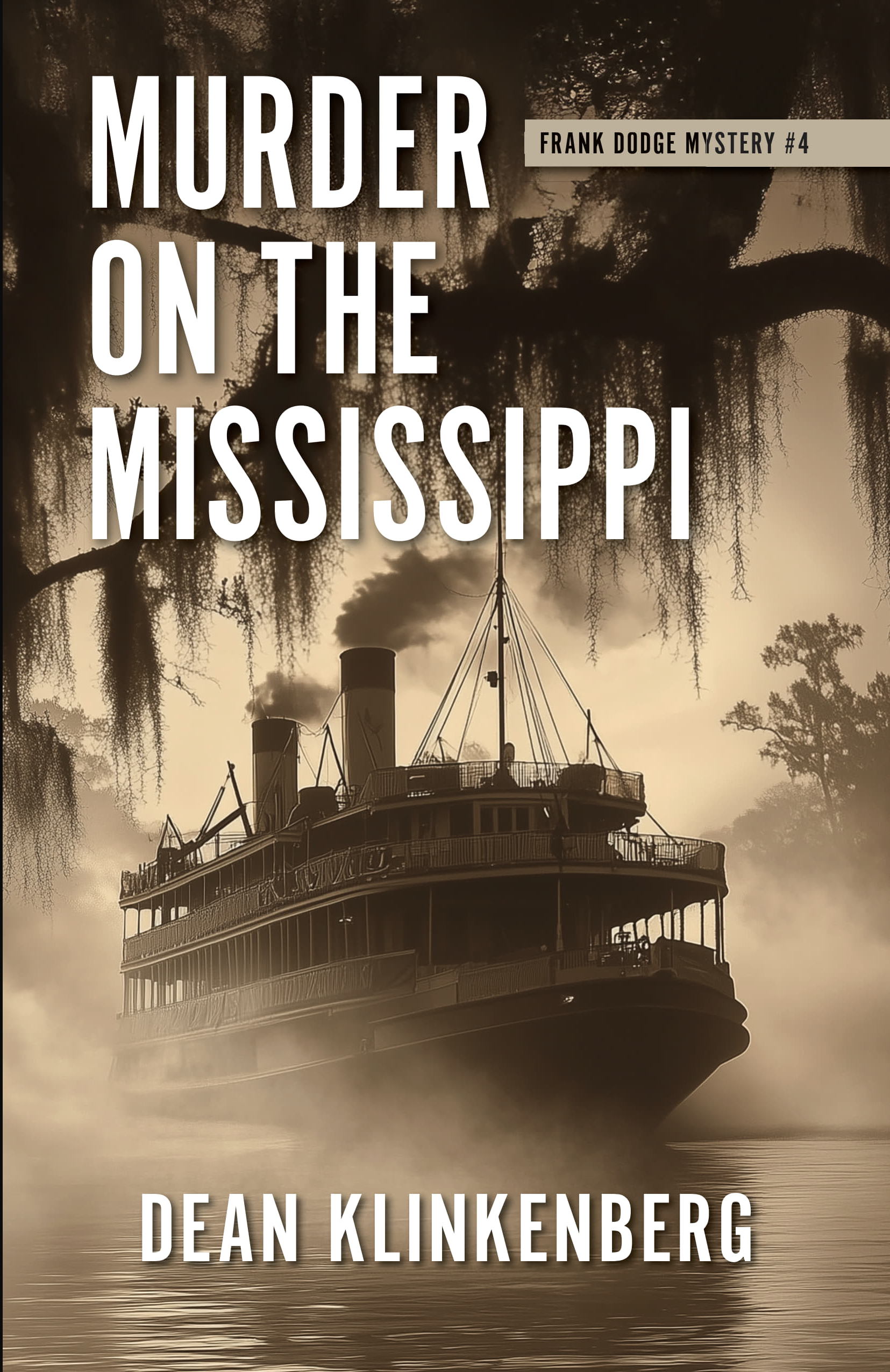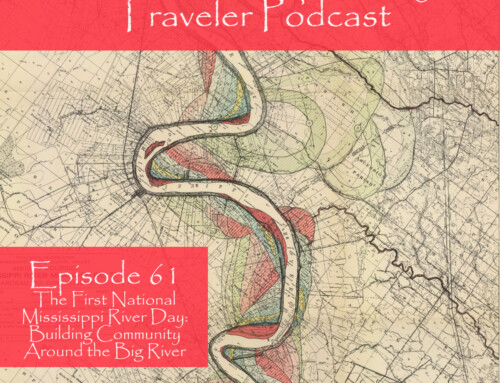In 1964, four members of the Ku Klux Klan killed two African American men in Mississippi. The story of their murder and the following decades of stops and starts in the prosecution of their killers inspired my latest Frank Dodge mystery: Murder on the Mississippi. In this episode, I give some background on the murder of Dee and Moore and how their murder influenced my latest book. Murder on the Mississippi takes place on a Mississippi River cruise from New Orleans to Memphis. The story centers around the story of three African American sisters whose father was killed in Vicksburg, Mississippi, in the 1970s by a gang of white men. They got a tip that the killers would be on the riverboat, so they booked a cruise to find them and hold them accountable. Their father’s murder, though, impacted each sister differently, which is one of the main themes of the novel. And while trying to find the killers, Dodge and his friends learn that some people on the boat aren’t who they claim to be. The book is already available for pre-order and officially releases on April 8, 2005.
Show Notes
Find a copy of Murder on the Mississippi
Find out more about the murders of Dee and Moore in Season 3 of David Rigden’s podcast, Someone Knows Something
Support the Show
If you are enjoying the podcast, please consider showing your support by making a one-time contribution or by supporting as a regular contributor through Patreon. Every dollar you contribute makes it possible for me to continue sharing stories about America’s Greatest River.
Don’t want to deal with Patreon? No worries. You can show some love by buying me a coffee (which I drink a lot of!). Just click on the link below.
Transcript
Wed, May 21, 2025 8:27AM • 26:27
SUMMARY KEYWORDS
Mississippi Valley Traveler, Frank Dodge series, Murder on the Mississippi, pre-order, release party, St. Louis, Mississippi River, Civil Rights era, Henry Dee, Charles Moore, Ku Klux Klan, FBI investigation, unsolved murders, Emmett Till Act, Thomas Moore.
SPEAKERS
Dean Klinkenberg
Dean Klinkenberg 00:27
Welcome to the Mississippi Valley Traveler Podcast. I’m Dean Klinkenberg, and I’ve been exploring the deep history and rich culture of the people and places along America’s greatest river, the Mississippi, since 2007. Join me as I go deep into the characters and places along the river and occasionally wander into other stories from the Midwest and other rivers. Read the episode show notes and get more information on the Mississippi at MississippiValleyTraveler.com. Let’s get going. Welcome to Episode 59 of the Mississippi Valley Traveler podcast. Well, Frank Dodge is back, and I’m going to devote this episode to telling you about the new book. It’s called “Murder on the Mississippi” and it’s the fourth book in the Frank Dodge series. I like to think you can read any of those the four books in the series as a standalone or part of the series. If you’re one of those folks who prefers to start at the beginning and follow through, I think this book will will be fine. It’s a standalone read as well. There are some storylines for Frank’s personal life that kind of follow a thread from beginning to end, and you may want to go back and catch up on some of that if you start with this book, but, but it’s certainly not critical to reading and enjoying this particular book. Let me read you the sales description for this so you can get a sense of the story itself. Some sins refused to stay buried. Murder was the last thing Frank Dodge expected to find on the Mississippi River cruise, but when three sisters board the riverboat River Voyager hunting for their father’s killers. Frank’s simple writing assignment transforms into a deadly game of cat and mouse. The stakes grow higher when another passenger vanishes overboard under suspicious circumstances. Joining forces with his friend Brian Jefferson, a homicide detective, Frank races against time to solve both mysteries before the cruise reaches Memphis. But the killers won’t give up their carefully crafted new identities without a fight. As Frank and his allies dig deeper, they discover the boat harbors dark secrets in its shadowy corners. With each revelation, they draw closer to a confrontation four decades in the making. Can they unmask the killers before another body hits the water? Murder on the Mississippi masterfully blends mystery and history against the haunting backdrop of America’s greatest river. Rich with complex characters and atmospheric detail, this riveting tale explores the true cost of justice delayed and the weight of unforgivable crimes. Step aboard for a cruise where the past and present collide in deadly fashion. Get “Murder on the Mississippi” today. So this book is already available for pre orders on all of the usual platforms. The official release is April 8. So you can have a copy in hand on April 8, if you pre order a copy now, and if you live in the St Louis area, I’m going to throw a release party on Sunday, April 27 at 6pm at the Schlafly tap room. I will post information about that in the show notes. Come on down if you want to buy a print copy, and I’ll be happy to sign it for you there, if you like. So the idea for this story had been bouncing around in my head for a few years, but it took a while to write. I had contracts from two publishers to write other books, to write “Mississippi River Mayhem” and “The Wild Mississippi”, and then in the middle of all that, in an 18 month stretch, both of my parents passed away, and I just didn’t have the enthusiasm to write much of anything for a few months at a time after each one passed away. But I’m back now. The inspiration for this book came from a story I learned a few years ago about the murder of two African American men in Mississippi in the 1960s that really raised a lot of questions for me, and I wrote about this in my book “Mississippi River Mayhem.” There’s a chapter about this, and I’m going to read that chapter to you next. So thanks to those of you who continue to support me through Patreon. I’m deeply grateful for your ongoing support. It makes me feel good, and your support keeps this podcast rolling along. If you’re not a Patreon kind of person, then you can buy me a coffee. So go to MississippiValleyTraveler.com/podcast, and you can buy me a coffee there, or you can get a link to join the Patreon community at the same link, MississippiValleyTraveler.com/podcast. You’ll also find links to all previous episodes, all 58 previous episodes that you can binge in the glory of Mississippi River history and storytelling. And you’ll also find the show notes for each episode, including this one. So now let’s get on with the story. It was May 2, 1964 and the air already felt Mississippi muggy in the United States, the Beatles latest single Can’t Buy Me Love rose to the top of the music charts From Russia with Love and the Carpetbaggers drew crowds to movie theaters. In Meadville, Mississippi, Henry Dee and Charles Moore, both 19 years old and with their eyes on the future, needed a ride. Dee was outgoing and personable, with a reputation for being a snappy dresser, a flare he may have picked up during one of the trips he took to Chicago to visit an aunt. Dee’s grandmother had raised him. She took him in after his mother was institutionalized for mental illness. Moore was a student at Alcorn A&M College. He was bright and curious and dreamed big. His father died when he was very young, so his mother had raised him and his brother, Thomas by herself. She pieced together a living by working in the home of a white family and from public assistance. Thomas Moore remembered, “We was three people that loved each other, cared about each other. You never thought about not spending your life with these people. ” Dee was trying to get to the nearby town of Roxie to pick up his paycheck from a lumber company where he worked. Moore just wanted to go home. They had stopped in a store where they each bought a honey bun and a large soda, and bumped into a friend, Joe Lee Rollins. They asked him for a lift, but Rollins father didn’t allow him to drive out of town, so Dee and Moore did what they had always done. They hitchhiked for a ride. Moore and Dee exited the store and stood near Meadville’s ice cream shop. A white Volkswagen pulled over and the driver offered them a ride. Dee and Moore turned him down, but the driver insisted they get in. He said he worked for the Internal Revenue Service, and he was investigating bootleggers in the area. He wouldn’t take no for an answer. They got in. The driver, James Ford Seale, drove them deep into the nearby Homochitto National Forest. Four men followed close behind in a pickup truck, Charles Marcus Edwards, Clyde Seal, Archie Prather and Curtis Dunn. None of them were federal agents. They were part of the Ku Klux Klan and an especially violent wing that was based around Franklin County. The Klan men had a mission. Outsiders were increasingly coming into Mississippi to dismantle the structures of white supremacy. Activists traveled around the region, organizing blacks to vote and challenging the status quo. African Americans were making demands for equal treatment. Some Klan members feared that African Americans were stockpiling weapons in preparation for a war to end white dominance. One of the Klan men, Edwards, had singled out Dee as someone who might be bringing guns into Franklin County. His frequent trips to Chicago made him suspicious to the Klan, and he sometimes wore a black bandanna, which the Klan associated with radical black activists. The Klan wanted Dee. Moore was in the wrong place at the wrong time In the forest, the Klan men tied Dee and Moore to a tree and beat them savagely. They asked them repeatedly to reveal the locations where blacks had been storing guns. The Klan men beat Dee and Moore until they bled and were nearly unconscious. Under duress, Dee and Moore told the Klan men that the Reverend Clyde Briggs had stored guns in the basement of Roxie Baptist Church. Edwards and two others left the forest and went right to local law enforcement with the “confession” they had obtained. Sheriff Wayne Hutto and patrolman Bernice Beasley went to the Roxy Baptist Church and searched it. They didn’t bother with a warrant. They searched the entire building, but didn’t find any weapons. Afterwards, they kept quiet about the search so folks wouldn’t know they’d been working with Klan. After Edwards and the others went to the sheriff, the other Klan men took Dee and Moore to Seale’s farm, where they called for more help. Two men answered, Ernest Parker and Seale’s brother Jack. Parker was part of a wealthy family in Natchez that had invested heavily in segregation. The Parkers had funded private whites only schools and supported Americans for the Preservation of the White Race, a white nationalist group. The Klan men tied up Dean Moore and taped their mouths shut, then tossed them into the trunk of a car that they had covered with a plastic tarp. For 90 minutes they drove traveling from Seale’s farm to Natchez, crossing the Mississippi River, then heading north to an isolated backwater slough near Davis Island, the place where Jefferson Davis, the president of the Confederate States of America, once lived in a big plantation. Ernest Parker and his brother, Robert Lee Parker III owned 1000s of acres on the island, so some locals called it Parker’s Island. The Parkers raised cattle on the island, but they also spent a lot of time hunting and fishing there. They had built a boat landing on the Louisiana side to make it easier to ferry supplies across. When the Klan men reached the landing, they stopped, opened the trunk and got Dee and Moore out. They were surprised to discover that both men were still alive, but it didn’t change their plans. They strapped Dee to an engine block from a 1944 Jeep, then put Dee into a boat. James and Jack Seale rode the boat into the Mississippi then threw Dee overboard, Moore almost certainly watched as his friend disappeared into the Mississippi River. The Klan men rowed back to shore then tied Moore to train rails. James Seale and Ernest Parker rowed the boat with Moore back into the middle of the channel and threw Moore into the water too. When Thomas Moore went home on leave in June 1964 after completing basic training, his brother was missing. No one, though, was searching for him. A story went around that Dee and Moore had gone to Louisiana to look for work. Moore and Dee might have disappeared into history as anonymous victims of Klan violence, if not for one big event on June 21 six weeks after the Klan men killed Dean Moore, three young men who had been working to register African American voters, James Cheney, Andrew Goodman and Michael Schwerner, vanished. Their disappearance made national news and triggered a massive search led by the FBI. On July 12, a fisherman spotted human remains, the lower half of a body on a piece of driftwood near Tallulah, Louisiana. The next day, another set of partial remains surfaced nearby. The bodies got the attention of the FBI. One of the dead men was wearing a bronze belt buckle with an M on it. So there was speculation that it could be the body of Michael Schwerner. It wasn’t, though. Officials tentatively identified the dead man as Dee and Moore. Thomas Moore was playing ping pong on base when he was told that his brother’s remains had been found. He went back home, where he made the heartbreaking confirmation that one of the men was indeed his brother, Charles. It was Thomas, after all, who had given that brass belt buckle to him. Charles’s death would haunt Thomas for decades. Divers returned to Davis Island in October and recovered more of the two men’s remains, as well as a Jeep engine and rails. The next month, on November 6, the Mississippi Highway Safety Patrol arrested James Ford Seale and Charles Marcus Edwards for the murders of Dee and Moore. Edwards confessed to picking up the men and beating them, but denied doing anything else. Seale didn’t admit to anything. They were released on bail the next day. Two months later, in early January 1965, the local District Attorney, Lenox Forman dropped the charges against Seale and Edwards. Forman said that the cases had become too difficult to prosecute because Seale and Edwards had alleged that law enforcement had mistreated them after being arrested. Forman probably also understood all too well that he had no chance of convincing an all-white jury in Mississippi to convict the two men. He was an elected official, so pursuing a case like that would have jeopardized his political career. Forman was also afraid of the Klan, and had cause to be. Klan members sometimes snuck onto his property at night and shot his cattle. Sometimes when he traveled to court hearings, he requested a police escort. Unknown to Forman, by September 1964 the FBI had gathered a lot of details about the Dee and Moore murders thanks to an informant within the Klan. The FBI, though, didn’t share any of that information with Forman or other local law enforcement, mainly because the FBI didn’t trust local law enforcement in Franklin County. Too many of them were affiliated with or sympathetic to the Klan. The FBI consumed with solving the murders of the three civil rights workers, assumed that Forman had accumulated enough evidence on his own to prosecute. The FBI also had that valuable informant, and given the ongoing threats, they didn’t want to jeopardize that information pipeline. After Forman gave up on pursuing the case. The FBI followed suit. By May 1966 no one at any level of law enforcement was investigating the murders of Henry Dee and Charles Moore. Hey, Dean Klinkenberg here, interrupting myself. Just wanted to remind you that if you’d like to know more about the Mississippi River, check out my books. I write the Mississippi Valley Traveler guide books for people who want to get to know the Mississippi better. I also write the Frank Dodge mystery series that is set in places along the Mississippi. My newest book, “The Wild Mississippi,” goes deep into the world of Old Man River. Learn about the varied and complex ecosystem supported by the Mississippi the plant and animal life that depends on them, and where you can go to experience it all. Find any of these wherever books are sold. For the next 30 years, no one bothered to investigate those murders either. By the mid 1990s momentum was building to reopen unsolved murder cases from the Civil Rights era. In 1994 a jury convicted Byron de la Beckwith of killing Medgar Evers back in the 1960s. Five years after that case, the journalist Connie Chung and producer Harry Phillips investigated a couple of civil rights era murders for the ABC news program 20/20. Of those cases was the Dee / Moore murders. Still the FBI decided not to pursue charges against anyone, and in June 2003 they closed the cases again. In 2005 Canadian journalist David Ridgen took an interest in the case. He reached out to Thomas Moore, who brushed Ridgen aside for weeks before finally talking to him. By that time, Thomas had retired after a 30 year career in the military, which included a tour in Vietnam as a gunner in a Huey helicopter. Thomas carried a heavy burden from his brother’s death, a mixture of grief and rage and self blame. He had always been there to look out for Charles, and couldn’t help but feel that he had let down his brother by not being there to protect him. It deeply troubled Thomas that no one had been held to account for killing him. He had sometimes fantasized about getting revenge against the men who killed Charles, but his mother had talked him down. When he retired from the military, he settled in Colorado. He had no intention of going back to Mississippi. He didn’t feel safe there. When Ridgen contacted him, he was living in Colorado, Thomas had no reason to trust a journalist, so he took his time responding. The two hit it off, though, and Thomas agreed to travel with Ridgen back to Mississippi to look into the case and to take part in a documentary that Ridgen was filming called “Mississippi cold case.” They soon learned that there were only two men still living who were involved in the murder, Charles Marcus Edwards and James Ford Seale. By the time Thomas Moore and Ridgen started piecing together the evidence, prosecutors had tried several other men for Civil Rights Era murders, juries had convicted each one. Thomas and Ridgen revisited the sites associated with the murders of Deek and Moore, consulted with the federal attorney Dunn Lampton, who had jurisdiction over the case, and poured through long forgotten FBI files. They even dropped in unannounced on Edwards and Seale, neither of whom welcomed their visit. Federal officials were soon able to convince Edwards to testify against Seale, though the combination of immunity from prosecution and Edwards troubled conscience was enough to convince him to break the oath of secrecy had taken when he joined the Klan decades earlier. Had he broken that oath, much earlier, the Klan would have killed him. On January 24, 2007 a federal grand jury returned an indictment against Seale for two counts of kidnapping and one count of conspiracy to kidnap. Police arrested Seale and put him in jail. Four months later, his trial began. Thomas Moore sat near the front of the courtroom to watch the proceedings, as did Thelma Collins, Henry Dee’s sister. Dee’s mother was still alive, but institutionalized, and the family had never told her that her son had been murdered. Seale, who was sickly enough that some, including his attorney, wondered if he’d survived the trial, did not take the stand in his own defense. In one of the more dramatic moments of the trial, Edwards from the witness chair, apologized to the Dee and Moore families and asked for forgiveness for his role in the murders. On June 14, the jury returned a quick verdict, Seale was guilty on all counts. Two months later, the judge sentenced the 71 year old Seale to life in prison. A year after that, while Seale was confined at the Federal Penitentiary in Terre Haute Indiana, an appeals court threw out his conviction, determining that the statute of limitations had expired. The full appeals court then reviewed the case, but split nine to nine. As a result, seale’s Conviction stood. On August 2, 2011 Seale died in prison. Thomas Moore and Thelma Collins accepted Edwards’ apology. They each took his hand and forgave him. It didn’t make up for what Edwards and the other Klan men had done, but for Moore anyway, it was an act that God demanded of him. Unlike Edwards, Seale never publicly owned up to his actions, and he never asked for anyone’s forgiveness. The bodies of Moore and Dee weren’t the only ones found in the Mississippi River. Most of the dead pulled from the river were African American. Elizabeth Sutherland Martinez, then a student working on the Mississippi Summer Freedom Project, observed in a letter, “Mississippi is the only state where you can drag a river anytime and find bodies you were not expecting. Things are really much better for rabbits, there’s a closed season on rabbits.” Justice was incomplete and slow for the killers of Charles Moore and Henry Dee, but at least it was served partially after the verdict came down, Thomas Moore said he felt like a tremendous burden had been lifted from him. In 2011, Thomas Moore went back to Meadville, Mississippi to talk with Edwards. They walked among the fruit trees Edwards tended and talked over coffee. They revisited the murders, their feelings about what had happened, about what God expected of them, and about reconciliation. The following Sunday, Thomas Moore joined Edwards for services at the Bunkley Baptist Church, a congregation that had once been exclusively white. Moore and Edwards sat together near the front. The trial in 2007 and Edwards’ apology couldn’t bring back Charles Moore and Henry Dee, and it certainly didn’t make up for the decades long reign of terror against African Americans, but the long sought conviction gave the family some closure. Thomas Moore felt a burden lifted. Justice was served to Seale. Small steps for sure, but at least they were forward. In 2008, President Bush signed the Emmett Till Unsolved Civil Rights Crime Act. The legislation directed the FBI to reopen unsolved murders of African Americans committed before December 31, 1969. The FBI identified 113 cold cases with 126 murder victims, which was almost certainly just a portion of the actual murders. Eight years later, the FBI had closed 105 of those cases. Only one had resulted in a conviction, though. Prosecuting perpetrators 40 plus years after a murder is extraordinarily difficult, as many of the people involved had died, double jeopardy also came into play at times, as some perpetrators had been tried once before and acquitted by all-white juries. Righting past wrongs is a monumental task, but as Thomas Moore said, “When you get an opportunity to correct some wrong, then you take that opportunity.” And sometimes the present catches up anyway. In 2015 voters in Natchez and Adams County, the area that had once been epicenter of Klan activity and where law enforcement often worked hand in hand with the Klan elected a black man, Travis Patten, as sheriff. So that’s where the idea for my new book began. I don’t want to spoil any plot points, but let’s just say that one of the issues that intrigued me was the lasting impact of a crime like that on family members and in Murder on the Mississippi, I get to explore that issue in some depth. As I mentioned, the book is now available for pre order everywhere books are sold, you can even go to your favorite local bookstore and order a copy. It officially releases on April 8, and if you’re in the St Louis area again on April 27 drop by the Schlafly tap room at 6pm for the release party, where you can buy print copies and get them signed. And by the way, if you haven’t seen the new book covers for the Frank Dodge series, check them out in the show notes or any of the online marketplaces. I really love these new covers, and feel like they come a lot closer to my original vision for the series than I was able to do when I first released those books. A very exciting time. I’m proud of this latest book. I hope you’ll enjoy it and let me know what you think about it. I’ll see you next time. Thanks for listening. If you enjoyed this episode, subscribe to the series on your favorite podcast app so you don’t miss out on future episodes. I offer the podcast for free, but when you support the show with a few bucks through Patreon to help keep the program going, just go to patreon.com/deanklinkenberg. If you want to know more about the Mississippi River, check out my books. I write the Mississippi Valley Traveler guide books for people who want to get to know the Mississippi better. I also write the Frank Dodge mystery series that’s set in places along the river. Find them wherever books are sold. The Mississippi Valley Traveler podcast is written and produced by me Dean Klinkenberg. Original Music by Noah Fence. See you next time you








